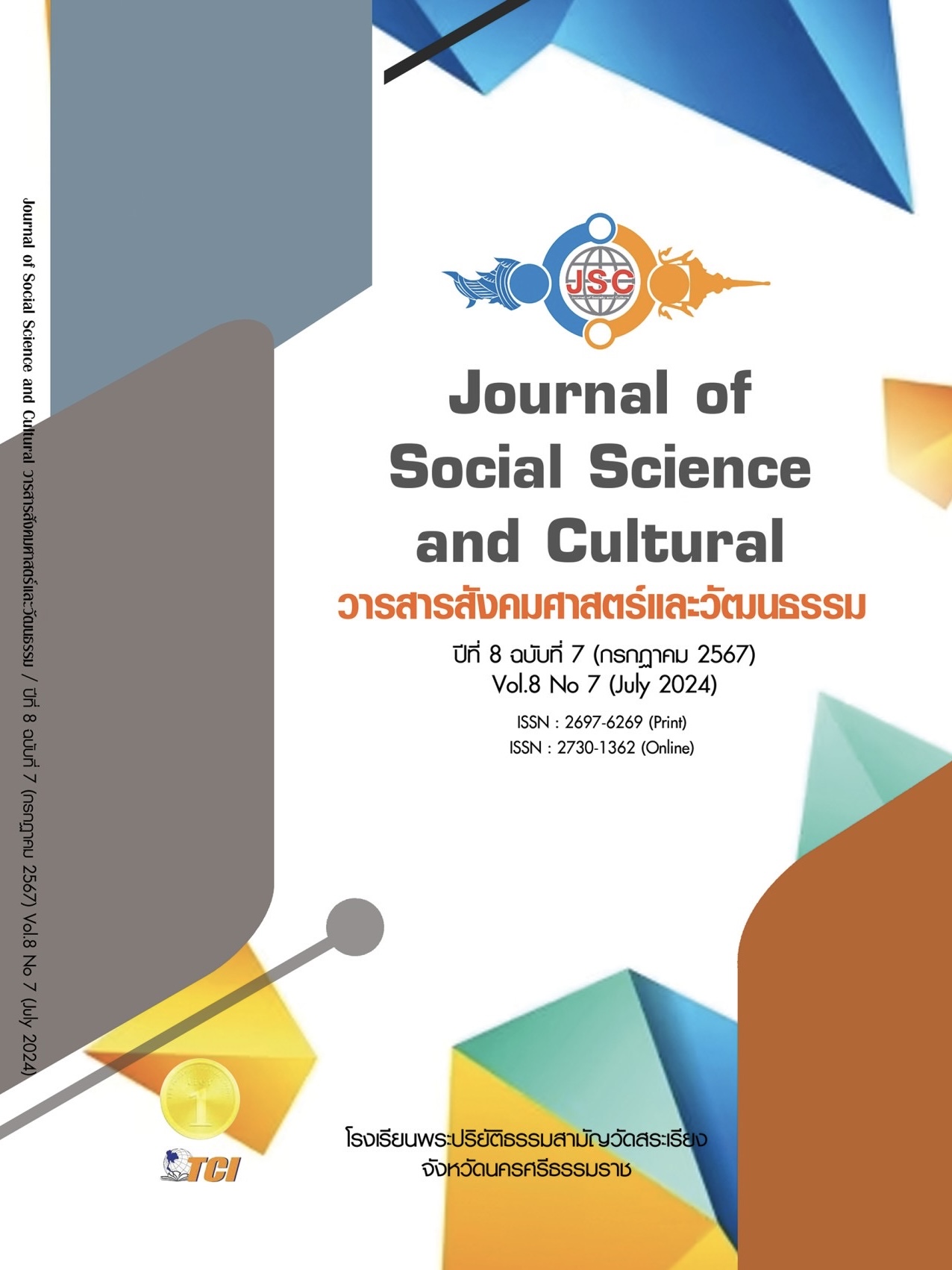INTERACTIONS IN THE LIFEWORLD OF Y-NOVEL READERS
Main Article Content
Abstract
This research is a qualitative study aiming to analyze the characteristics of the public spaces inhabited by readers of Boys' Love (BL) novels within their lifeworld and to examine the interactions of BL novel readers in these public spaces through the lifeworld perspective. The methodology employed follows narrative inquiry under the constructivist paradigm. The study selects a theoretical narrative group of BL novel readers who engage with these novels both in book form and online platforms, and who participate in discussions about BL novels on these online platforms or have interactions among reader groups. The sample consists of 10 individuals aged 15-45, representing all genders to ensure diversity in the data. A purposive sampling method is used, focusing on those who interact both offline and online. In-depth interviews are conducted to collect data, leading to an understanding of various groups of BL novel readers. The researcher utilizes Van Maanen's approach to data analysis, interpreting and extracting the essence of the experiences from the narrators. Reflective thinking and analysis are applied to identify key components of the data through the main conceptual framework established by the researcher. The results reveal that the public spaces within the lifeworld of BL novel readers, and the interactions within this lifeworld, serve as venues for the free exchange or transformation of opinions. The lifeworld functions as a medium for transmitting knowledge through interpersonal interactions and acts as a safeguard against social fragmentation, as it comprises shared assumptions and areas of knowledge that facilitate consensual conclusions during interactions or debates.
Article Details
References
คุณกบ. (30 เม.ย. 2567). ปฏิสัมพันธ์ของกลุ่มผู้อ่านนิยายวายบนพื้นที่ออนไลน์และกลุ่มสังคม. (นิภาพรรณ กิตติผดุงชัย, ผู้สัมภาษณ์)
คุณอุ้ม. (30 เม.ย. 2567). ปฏิสัมพันธ์ของกลุ่มผู้อ่านนิยายวายบนพื้นที่ออนไลน์และกลุ่มสังคม. (นิภาพรรณ กิตติผดุงชัย, ผู้สัมภาษณ์)
จันทร์สุดา ไชยประเสิรฐ์. (2564). กลวิธีการแต่งในนวนิยายวายไทย. ใน วิทยานิพนธ์ศึกษาศาสตรมหาบัณฑิต สาขาวิชาการสื่อสารภาษาไทยเป็นภาษาที่สอง. มหาวิทยาลัยหัวเฉียวเฉลิมพระเกียรติ.
เจมส์ กอร์ดอน ฟินเลย์สัน. (2559). Habermas: a very short introduction [ฮาเบอร์มาส: มนุษย์กับพื้นที่สาธารณะ]. (พิมพ์ครั้งที่ 1). กรุงเทพมหานคร: สำนักพิมพ์สวนเงินมีมา จำกัด.
ชวิตรา ตันติมาลา. (2560). พื้นที่สาธารณะและการผลิตพื้นที่: ความหมายใหม่ของความสัมพันธ์ทางสังคม. ใน ดุษฎีนิพนธ์ปรัชญาดุษฎีบัณฑิต สาขาวิชาพฤติกรรมศาสตร์ประยุกต์. มหาวิทยาลัยศรีนครินทรวิโรฒ.
ไทยโพสต์. (2566). งานสัปดาห์หนังสือโกยเงิน 350 ล้าน “การ์ตูน-นิยาย” ขายดีที่สุด. เรียกใช้เมื่อ 15 กันยายน 2566 จาก https://www.thaipost.net/news-update/361840/
ดุษฎี ดำนิล และนิตยา พรมศรี. (2566). readAwrite: จากแพลตฟอร์มนิยายออนไลน์ยอดนิยมสู่การสร้างวัฒนธรรมแฟนคลับ. วารสารศิลปวัฒนธรรมสวนสุนันทา, 3(1), 17-28.
นฤพร ปู่แตงอ่อน. (2564). นิยายออนไลน์ ช่องทางเลือกของนักอ่าน หรือทางรอดของนักเขียน. ใน วิทยานิพน์การจัดการมหาบัณฑิต สาขาการจัดการ. มหาวิทยาลัยมหิดล.
น้องJK. (2 พ.ค. 2567). การใช้พื้นที่สาธารณะของกลุ่มผู้อ่านนิยายวายในรูปแบบออนไลน์. (นิภาพรรณ กิตติผดุงชัย, ผู้สัมภาษณ์)
น้องเตย. (1 พ.ค. 2567). ประสบการณ์การใช้พื้นที่สาธารณะในรูปแบบออนไลน์และกลุ่มสังคมของผู้อ่านนิยายวาย. (นิภาพรรณ กิตติผดุงชัย, ผู้สัมภาษณ์)
น้องเอ. (1 พ.ค. 2567). มุมมองและความคิดเห็นเกี่ยวกับพื้นที่สาธารณะของชุมชนผู้อ่านนิยายวาย. (นิภาพรรณ กิตติผดุงชัย, ผู้สัมภาษณ์)
นันทิชา ลือพืช. (2560). การสร้างความหมายและแสดงตัวตนของสาววาย ในพื้นที่ออฟไลน์และพื้นที่ออนไลน์. ใน วิทยานิพนธ์ศิลปศาสตรบัณฑิต สาขาวิชาปรัชญา การเมือง และเศรษฐศาสตร์. มหาวิทยาลัยธรรมศาสตร์.
ประชาชาติธุรกิจ. (2567). สัปดาห์หนังสือ 2567 ปิดฉากโกยยอดขาย 400 ล้านบาท นักอ่านร่วมงาน 1.3 ล้านคน. เรียกใช้เมื่อ 11 เมษายน 2567 จาก https://www.prachachat.net/d-life/news-1539330
รื่นฤทัย สัจจพันธุ์. (2560). การอ่านวรรณกรรม Gen z. (พิมพ์ครั้งที่ 1). กรุงเทพมหานคร: แสงดาว.
ศิรินภา นรินทร์ และรุ่งนภา พิมมะศรี. (2563). “วาย” วัฒนธรรมเฉพาะกลุ่มก้าวสู่กระแสหลัก ขุมทรัพย์ใหม่ธุรกิจบันเทิง-หนังสือ. เรียกใช้เมื่อ 22 กุมภาพันธ์ 2565 จาก https://www.prachachat.net/d-life/news-538162.
สิริกร ทองมาตร. (2561). อ่าน “ฟิค” บนสื่อดิจิทัล: ชาติพันธุ์วรรณาของแฟนฟิคชันศิลปินเกาหลี. ใน วิทยานิพนธ์สังคมวิทยาและมานุษยวิทยามหาบัณฑิต สาขามานุษยวิทยา. มหาวิทยาลัยธรรมศาสตร์.
Habermas, J. (2004). Public space and political public sphere – the biographical . In Commemorative Lectures. The 2004 Kyoto Prize.
Seidman, S. (1989). JÜrgen Habermas on society and politics. Boston: Beacon.
The Bangkok Insight Editorial Team. (2562). ทำความรู้จักแอพ“Joylada-จอยลดา”นิยายแชทรูปแบบใหม่ที่มาแรงสุดในตอนนี้. เรียกใช้เมื่อ 22 กุมภาพันธ์ 2564 จาก https://www.thebangkokinsight.com/news/digital-economy/84568/
van Manen. (1990). Researching Lived Experience: Human Science for an Action Sensitive Pedagogy. London: Althouse.

